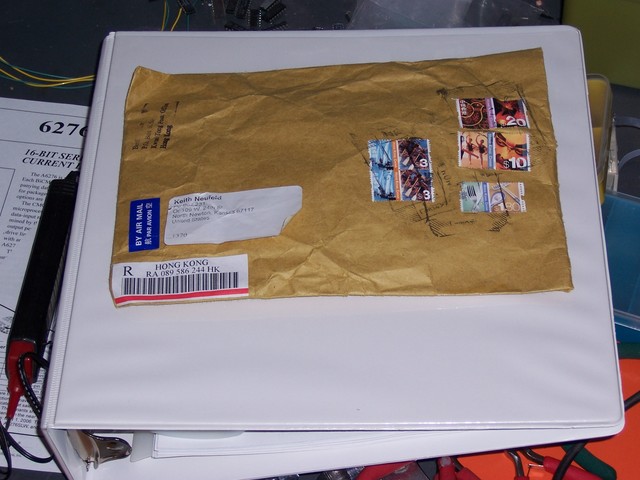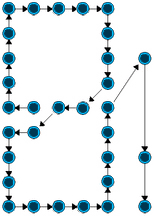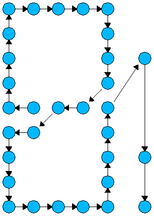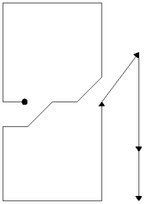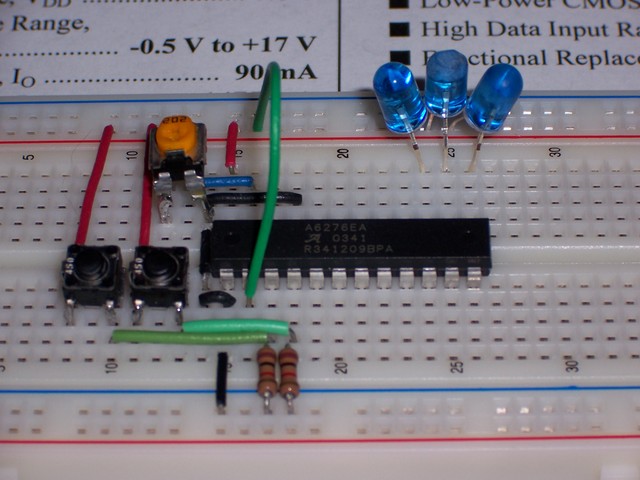Package from Hong Kong
My LEDs arrived last weekend. Here’s how you ship 498 LEDs and 100 of the wrong resistors from Hong Kong:
Yes, 498. Of course I counted them. Best Hong Kong has a reputation for great prices and terrible customer service, so I was curious how much they were going to mess up my order. A little bit and then some, as it turns out.
By the way, here’s how to count more than a couple dozen small objects. Get a container to use as a discard pile, then count “3-6-9″ into the discard, “10″ into a new holding pile. “3-6-9″ discard, “10″ holding, etc., until you have few enough left that they don’t make 10. Move that remainder to the ones place of your answer row.
Now count your holding pile, each object of which represents 10 original objects. “3-6-9″ into the discard, “10″ into a new holding pile. When you have less than 10 left, that’s the tens place of your answer row. Repeat for 100s, 1000s, etc. as needed. When you’re done, read off the answer by counting the objects in the different places in the answer row.
It’s really efficient to do, for several reasons. First, three is about the largest number of objects that most people can cluster quickly and with absolute certainty, so you’re going through the objects as quickly as possible without actually counting. Second, that last part is important–because you’re not counting, there’s never anything to remember (other than 3-6-9), and it’s virtually impossible to lose your place. Finally and related, you use the objects themselves as placeholders to store and remember your result.
4, 9, 8. Not quite 500, but close enough that I can forgive them.
Wrong Resistors
The resistors, however, are another matter. Best Hong Kong explicitly advertised free resistors on this auction, and their instructions explicitly said to specify my choice of resistor value as a comment during checkout. I did so–I added this note to my PayPal checkout:
If you have ’1000-ohm’ resistors, please make all of my free resistors ’1000-ohm’.
If you don’t have ’1000-ohm’ resistors, please make my resistors ’220-ohm’.
Thank you!
They sent 470Ω resistors–their recommendation to use with blue LEDs on 12V automotive systems. Not acceptable. I want my 1K resistors to use for miscellaneous projects, or my 220Ω resistors to use with LEDs.
Monday morning, I sent an email directly to Best Hong Kong explaining the situation:
Subject: Received item #7605792211 but wrong resistors
To: ***@BESTHONGKONG.COM (KEN)
Date: Tue, 27 Jun 2006 10:28:53 -0500 (CDT)Yesterday I received my shipment of 500 XtraBright 5mm 10000mcd+ F/S F/R
LEDs, eBay item number 7605792211. However, the free resistors weren’t
right: I received 470ohm resistors instead of either 1Kohm or 220ohm
resistors like I requested in my PayPal checkout:> Amount: $51.35 USD
>
> Transaction ID: 8Y445643T3613431N
>
> Subject: Blue LED Set of 500 XtraBright 5mm 10000mcd+ F/S F/R
>
> Note:
> If you have ’1000-ohm’ resistors, please make all of my free resistors
> ’1000-ohm’.
>
> If you don’t have ’1000-ohm’ resistors, please make my resistors
> ’220-ohm’.
>
> Thank you!Since the auction advertised my choice of resistors, I think you owe me
a set of 1Kohm or 220ohm resistors as I requested. Are you the right
person to contact? What can we do to work this out?
I got no response. Wednesday I submitted the same message through eBay, and haven’t received a response. I just opened a dispute through eBay and PayPal, sending this message:
After purchasing my LEDs on eBay, I followed your instructions to select my free resistors, and specified my choice of resistors as a note on my PayPal payment. I requested that the resistors be 1000-ohm resistors if possible, or 220-ohm resistors (which you listed as an option on the auction page) if you couldn’t provide 1000-ohm resistors.
I received my LEDs and they appear to be fine, but the resistors that were shipped were 470-ohm resistors–not what I asked for.
Since your auction posting offers for me to specify my choice of free resistors, and I followed your instructions to do so, I think you owe me the 1000-ohm or 220-ohm resistors that I requested.
I’m sorry to have to open a dispute through eBay and PayPal, but you haven’t responsed to the email I sent five days ago and the email I sent through eBay three days ago.
We’ll see what happens.
